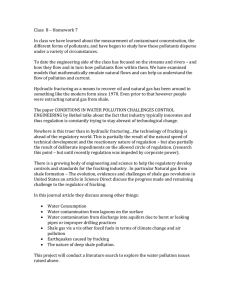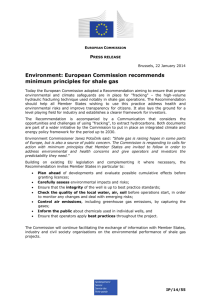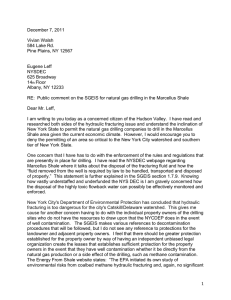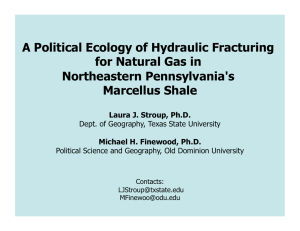Regulating Hydraulic Fracturing: States Take Action
advertisement
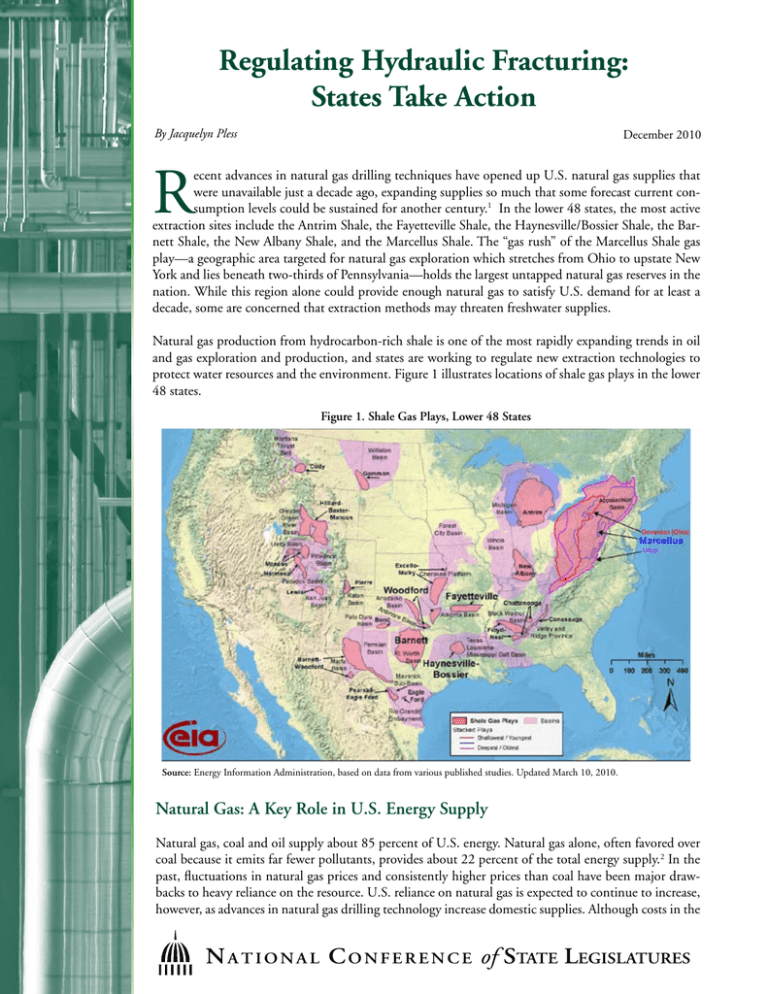
Regulating Hydraulic Fracturing: States Take Action By Jacquelyn Pless December 2010 R ecent advances in natural gas drilling techniques have opened up U.S. natural gas supplies that were unavailable just a decade ago, expanding supplies so much that some forecast current consumption levels could be sustained for another century.1 In the lower 48 states, the most active extraction sites include the Antrim Shale, the Fayetteville Shale, the Haynesville/Bossier Shale, the Barnett Shale, the New Albany Shale, and the Marcellus Shale. The “gas rush” of the Marcellus Shale gas play—a geographic area targeted for natural gas exploration which stretches from Ohio to upstate New York and lies beneath two-thirds of Pennsylvania—holds the largest untapped natural gas reserves in the nation. While this region alone could provide enough natural gas to satisfy U.S. demand for at least a decade, some are concerned that extraction methods may threaten freshwater supplies. Natural gas production from hydrocarbon-rich shale is one of the most rapidly expanding trends in oil and gas exploration and production, and states are working to regulate new extraction technologies to protect water resources and the environment. Figure 1 illustrates locations of shale gas plays in the lower 48 states. Figure 1. Shale Gas Plays, Lower 48 States Source: Energy Information Administration, based on data from various published studies. Updated March 10, 2010. Natural Gas: A Key Role in U.S. Energy Supply Natural gas, coal and oil supply about 85 percent of U.S. energy. Natural gas alone, often favored over coal because it emits far fewer pollutants, provides about 22 percent of the total energy supply.2 In the past, fluctuations in natural gas prices and consistently higher prices than coal have been major drawbacks to heavy reliance on the resource. U.S. reliance on natural gas is expected to continue to increase, however, as advances in natural gas drilling technology increase domestic supplies. Although costs in the N a t i o n a l C o n f e r e nc e of State Legislatures Regulating Hydraulic Fracturing: States Take Action past have generally fluctuated between $3 per MMBtu (1,000 cubic feet of natural gas) and $13 per MMBtu, they are expected to remain between $5.5 per MMBtu and $7.5 per MMBtu until 2030; new shale gas supplies are expected to help sustain lower prices.3 Figure 2 illustrates domestic conventional and unconventional gas supply projections through 2040. Figure 2. Conventional/Unconventional Gas Source: National Energy Technology Laboratory, U.S. Department of Energy. In general, natural gas produced from unconventional sources (shale gas, tight sands and coalbed methane) is expected to constitute an increasing portion of the U.S. reserves as conventional gas reserves decline. Shale gas is estimated to make up 28 percent or more of total estimated technically recoverable gas resources in the United States.4 Natural gas is found in porous rock reservoirs beneath the earth’s surface. Fossil fuel fills gaps or cracks in rock, and hydraulic fracturing allows release of trapped natural gas. The main differences between modern shale gas development and conventional natural gas development are the uses of horizontal drilling and hydraulic fracturing. What Is Fracking? Hydraulic fracturing—“fracking’’—uses hydraulic pressure to break up rock. Millions of gallons of pressurized liquids, usually a water-based mixture of sand and chemical additives, are pumped into geologic formations to force open cracks and gaps to optimize natural gas extraction. Following fracturing, a proppant, com- 2 monly sand, is pumped into cracks to keep them open while the gas is removed. The first use of fracking for oil or gas production occurred in the 1940s. Since then, the technology has been commonly used in completion of gas wells, especially when drilling into shale reservoirs. It is estimated that approximately 70 percent of the world’s fracturing activity occurs in North America.5 Hydro-fracking significantly enhances gas recovery in vertical wells by increasing available pathways for fluid movement, which is even more substantial in horizontal wells. The advancement of hydraulic fracturing and horizontal drilling technologies allows shale gas development in previously inaccessible areas, some of which are densely populated. Although fracking for natural gas extraction offers economic benefits to local communities, its rapid expansion near populated areas has drawn attention to its potential effects on human health and the environment. Local Economic Effects of Natural Gas Fracking Besides the benefits incurred from increasing domestic natural gas supplies, resource development spurs rippling economic effects. Activities before, during and after drilling generate positive economic effects, which may be substantial. Job creation is likely the most significant effect, since workers are needed for legal and regulatory work, construction and infrastructure development. Local, state and federal tax revenues are generated, and additional expenditures by workers in drillingrelated jobs and royalties stimulate the local economy. A recent study by professors at Pennsylvania State University evaluates the economic impacts of the Pennsylvania Marcellus Shale natural gas play. They estimate that, in 2009, the sum of direct, indirect and induced impacts from the development of Marcellus Shale totaled more than $7.17 billion with industry providing a direct stimulus of $3.77 billion to the local economy.6 An additional $1.56 billion is added to total state gross output as direct stimulus leads to spending by other firms, and direct and indirect business activities are estimated to generate income resulting in the purchase of $1.84 billion in additional goods and services. The study estimates that 21,000 direct jobs and 44,000 total (including indirect and induced) jobs were created in Pennsylvania in 2009 from Marcellus Shale develop- National Conference of State Legislatures Regulating Hydraulic Fracturing: States Take Action ment. Job creation and economic output resulted in an increase of more than $389 million in state and local tax revenues and $1.05 billion in federal taxes in Pennsylvania.7 Although economic impact studies can help municipalities identify potential gains from natural gas development, limitations exist that communities must consider. Most impact studies analyze only employment and income and do not address the distribution of money or who benefits from development activities. Often ignored are potential negative impacts on other sectors, distribution of tax revenue, impact on local government services, and environmental costs and implications.8 Human Health and Environmental Concerns A recent study funded by the U.S. Department of Energy (DOE) found fracturing fluids are 98 percent to 99.5 percent water by volume. Between three and 12 chemical additives typically are used for a fracture.9 These additives serve various purposes, but generally improve efficiency and help carry sand into fractures. Department of the Interior is also considering disclosure rules. After injection, fracking fluid mixes with water and absorbs naturally occurring radiation, salts and metals.10 Some fluids cannot be recovered from the cracks following a treatment, and pressure from the formation may cause some to flow back through the well casing to the wellhead.11 Recovered water is either stored or recycled to be discharged into surface water or injected underground. Flowback can continue for several months after gas production has begun.12 Many question where the wastewater goes once it has been used to extract gas. While flowback fluid presumably is stored until it can be disposed of or reused, tears in storage liners have led to spills into local water supplies. Hydraulic fracturing is suspected to be the cause of incidents of drinking water contamination in several states. In 2009, a U.S. Environmental Protection Agency (EPA) investigation of the Pavilion area in Fremont County, Wyo., found that harmful substances contaminated 11 of 39 water wells near hydro-fracking operations. Residents noted changes—such as a yellow color, oil sheen and small gas bubbles—in their drinking water.13 In Pennsylvania, 13 families have filed a lawsuit claiming their well water was contaminated by nearby hydraulic fracturing operations, exposing them to harmful chemicals. Water Use Approximately 2 million to 4 million gallons of water are needed to drill and fracture a horizontal shale gas well.14 Although this volume can be relatively small for an area’s overall surface water budget, using that much water in a short time period may challenge infrastructure and supplies.15 Significant water withdrawals could affect municipal water supplies, aquatic life, fishing and recreational activities, and industries such as power plants that depend on water use. Natural Gas Fracking Operation Source: Richard Waite, World Resources Institute. Some are concerned about the chemicals used in fracking fluid. Because fluids are pumped into the ground and portions flow back to the wellhead following a fracture treatment, groundwater contamination is possible. Although no state has passed legislation requiring disclosure of fracking ingredients, Wyoming’s Oil and Gas Conservation Commission set new rules, effective September 2010, requiring companies to submit a comprehensive list of the substances that are injected into wells during hydraulic fracturing procedures. The U.S. It is critical to identify water supplies that can meet the needs for drilling and fracturing without interfering with current community needs. One option suggested by the DOE is adapting to seasonal changes to capture water when surface water flows are greatest. It can be helpful for operators to work with local water planning agencies, however, to fully understand specific regional needs. National Conference of State Legislatures 3 Regulating Hydraulic Fracturing: States Take Action Federal Regulation State Action In June 2009, Congress introduced the Fracturing Responsibility and Awareness of Chemicals (FRAC) Act (HR 2766 and S. 1215). Although neither bill passed, if enacted, they would have removed a current exemption from the Safe Drinking Water Act commonly known as the “Halliburton Loop,” which exempts hydraulic fracturing from restrictions on underground injection near drinking water sources. The act also would have required disclosure of chemicals in the fracking fluid for each operating source, and the U.S. Environmental Protection Agency (EPA) would have regulated hydraulic fracturing. While the energy industry argued the FRAC Act adds unnecessary and cumbersome regulation and that states already adequately regulate hydro-fracking, others claimed it would address problems that currently are ignored. Lawmakers in Alabama, Alaska, Louisiana, Mississippi, North Dakota, Oklahoma, Pennsylvania, Texas, Utah, and Wyoming, recognizing the benefits fracking brings to local economies and landowners, introduced legislation urging Congress not to remove the exemption from the Safe Drinking Water Act. Alabama, North Dakota, Oklahoma, Utah and Wyoming adopted the resolutions. New Jersey and Pennsylvania introduced resolutions supporting passage of the FRAC Act. State agencies have the power to regulate, permit and enforce all activities relating to natural gas development. Every state where oil and gas is produced has at least one regulatory agency that permits wells and sets environmental regulations. Severance taxes also can benefit states, although some argue they limit production. In November 2010, the U.S. Department of the Interior announced it was considering changing regulations to require drillers to disclose fracking chemicals used on federal land, which is drawing support and opposition from members on both sides of the aisle. Environmental Protection Agency Study The EPA is conducting a nationwide study to assess the environmental and public health effects of hydraulic fracturing. Initial results are expected to be available by late 2012. In response, a number of related bills were introduced in New York. One would place a moratorium on the disposal or processing of fluids used in a hydraulic fracturing process performed outside the state (AB 10710), while others (SB 7592, SB 7593 and AB 10490) would establish a moratorium on hydraulic fracturing for natural gas or oil extraction until study results are released. 4 Protecting Water Resources • Recent incidents have drawn special attention to hydraulic fracturing, and some states believe greater oversight is needed. Michigan, New York, Ohio, Pennsylvania and Wyoming, for example, are considering requiring disclosure of all chemicals added to each well’s particular fracking cocktail. No legislation has been adopted to date. • A Louisiana resolution (HCR 1) requests the Ground Water Resources Commission to prepare a report on ground and surface water resources. The commission also is to provide recommendations to manage and protect water resources, specifically in areas of the state where increased water usage is associated with hydraulic fracturing. • West Virginia is considering a bill (HB 4513) to establish requirements for water use in Marcellus gas well operations. Before drilling, if a gas well in Marcellus will use more than 210,000 gallons in state water resources during any month, the operator must submit a form tracking aspects of the process, including the amount of water used for hydraulic fracturing, flowback water, and method of management or disposal. • Michigan is considering a bill (SB 1532) that presumes liability for the operator of a well that uses hydro-fracking if the groundwater in the vicinity is found to contain at least one hazardous substance originally injected into the nearby well during the hydraulic fracturing process. • Bills introduced in Ohio (SB 165, SB 196 and HB 426) would modify environmental safety standards relating to drilling; provide for spill and leak warning systems; require permits; require well inspections and monitoring systems; and require operators to submit a list of substances in hydraulic fracturing fluids. National Conference of State Legislatures Regulating Hydraulic Fracturing: States Take Action More comprehensive fracking legislation has been introduced in New Jersey, New York and Pennsylvania. In New York, AB 8748 would require disclosure of hydrofracking materials, prohibit natural gas drilling near watersheds, require spills to be immediately reported, and require that all chemical components be tracked. Another bill, New York AB 10092, would require an environmental impact statement for any natural gas or oil drilling that involves use of hydro-fracking fluid. Senate Bill 7377 addresses liability, making landowners who enter into or extend leases with natural gas developers partially responsible for damage caused by hydraulic fracturing activities. New York SB 6654 would prohibit drilling within a certain distance of drinking water sources, and AB 6953 would prohibit use of toxic fracking solutions. Pennsylvania legislators have introduced more than 10 bills addressing hydro-fracking. Proposals include provisions relating to well permits, location restrictions (such as maintaining a certain distance from water sources), reporting requirements, well spacing, and monitoring hydraulic fracturing fluids. In New Jersey, some lawmakers have taken a more aggressive approach, introducing legislation (AB 3313) that would ban the use of hydro-fracking in the state for natural gas exploration or production. Severance Taxes Severance taxes traditionally are based on the volume or value of gas extracted or on a combination of these two methods. Ranking 15th in natural gas production among the states, Pennsylvania is the largest producer that has no severance tax. In September 2010, however, the Pennsylvania House passed a bill that would implement a severance tax on natural gas. The Senate version of the bill, SB 1155, would set a fixed tax rate of $0.39 per 1,000 cubic feet (MCF) of gas produced, generating $144.3 million in 2010-11 and $326.1 million in 201112.16 The legislation remains under consideration. Although the most recent proposal in Pennsylvania is volume-based, various severance taxes have been debated. An earlier proposal reflected West Virginia’s 5 percent tax on the wellhead value plus 4.7 cents/MCF extracted.17 Louisiana uses a volume-based tax rate similar to the one currently proposed in Pennsylvania.18 Arkansas and Texas, on the other hand, use value-based taxes. Those who oppose the tax in Pennsylvania argue that severance taxes may limit production should potential producers instead choose to drill in New York, for instance (another Marcellus Shale state that has no severance tax on natural gas). New York’s production tax is based on the amount of natural gas produced on a property. A recent study concludes that, although a severance tax on natural gas in Pennsylvania would increase costs for gas drillers, spending the state revenue generated by the tax could still have small, but positive, effects on the state’s economy.19 Other studies illustrate energy taxes, including severance taxes, have little effect on energy producers’ actions, and research has shown that changes in severance tax rates may significantly affect government revenues but not industry production.20 Some argue that a severance tax could provide resources to mitigate possible environmental impacts of natural gas extraction.21 Conclusion Although hydraulic fracturing has been a game-changing technique for natural gas exploration and production, its explosive growth has raised questions regarding potential environmental effects and adequate regulation. States are responsible for environmental protection during fracking procedures, but some in Congress support increased federal oversight. While the EPA currently is conducting an environmental impact review of fracking, states are continuing efforts to regulate fracking to ensure access to critical natural gas resources while protecting increasingly scarce freshwater supplies. Notes 1. This is according to research conducted by the Potential Gas Committee at the Colorado School of Mines in 2009. See www.mines.edu/Potential-GasCommittee-reports-unprecedented-increase-in-magnitude-of-U.S.-natural-gas-resource-base. 2. U.S. Energy Information Administration, Annual Energy Outlook 2008 with Projections to 2030 (Washington, D.C.: U.S. EIA, June 2008); http://www.eia. doe.gov/oiaf/aeo/pdf/0383(2008).pdf. 3. Kevin Petak, ICF International, Powerpoint Presentation (April 20, 2010); www.naseo.org/events/summer/2010/presentations/Petak.pdf. 4. Gordon Pickering and Richard Smead, North American Natural Gas Supply Assessment (Rancho Cordova, Calif.: Navigant Consulting Inc., June 2008). National Conference of State Legislatures 5 Regulating Hydraulic Fracturing: States Take Action 5. Chariag, Belgacem, Schlumberger Inc., “Maximize reservoir contact,” Global Exploration & Production News (January 2007). 6. Timothy J. Considine et al., The Economic Impacts of the Pennsylvania Marcellus Shale Natural Gas Play: An Update (University Park, Pa.: Pennsylvania State University, Department of Energy and Mineral Engineering, May 2010). 7. Ibid. 8. Timothy W. Kelsey, Marcellus Shale Impact: What Do the Economic Impact Studies Imply? Penn State Cooperative Extension Webinar on March 18, 2010; http:// extension.psu.edu/naturalgas/presentations/marcellusshale-impact-what-do-the-economic-impact-studiesimply. 9. Ibid. 10. U.S. Department of Energy, Modern Shale Gas Development in the United States: A Primer (Oklahoma City, Okla.: Ground Water Protection Council, April 2009). 11. U.S. Environmental Protection Agency, Hydraulic Fracturing Background Information (Washington, D.C.: U.S. EPA, September 2010); http://water. epa.gov/type/groundwater/uic/class2/hydraulicfracturing/wells_hydrowhat.cfm. 12. D.M. Willberg et al., Optimization of Fracture Cleanup Using Flowback Analysis, SPE Rocky Mountain Regional/Low-Permeability Symposium (Richardson, Texas: Society of Petroleum Engineers Inc., 1998). 13. U.S. Environmental Protection Agency, Expanded Site Investigation Analytical Results Report, Pavilion Area GW Investigation, Pavilion, Fremont County, Wyoming, Prepared by Rebecca Laramie, Deputy Program Manager. EPA Region 8 (Denver, Colo.: URS Operating Services, Inc., August 2010); http://www. epa.gov/region8/superfund/wy/pavillion/PavillionAnalyticalResultsReport.pdf. 14. J. Satterfield et al., Chesapeake Energy Corporation, Managing Water Resource Challenges in Select Natural Gas Shale Plays, presented at the GWPC Annual Meeting, September 2008; http://www.gwpc.org/meetings/forum/2008/proceedings/Ground%20Water%20 &%20Energy/SatterfieldWaterEnergy.pdf. 15. U.S. Department of Energy, Modern Shale Gas Development in the United States: A Primer (Oklahoma City, Okla.: Ground Water Protection Council, April 2009). 16. Pennsylvania Budget and Policy Center, House Approves Natural Gas Severance Tax Bill, State Budget and Tax Policy (Harrisburg, Pa.: PBPC, September 2010); http://www.pennbpc.org/house-approves-natural-gas-severance-tax-bill. 17. Francis A. Muracca and Thomas E. Zahn, The Marcellus Shale Formation: Pennsylvania’s Natural Gas Severance Tax Debate (n.p.: Martindale-Hubbell Legal Library, Oct. 5, 2010); http://www.martindale.com/ natural-resources-law/article_Jones-Day_1160300. htm. 18. Ibid. 19. Rose M. Baker and David Passmore, Benchmarks for Assessing the Potential Impact of a Natural Gas Severance Tax on the Pennsylvania Economy (University Park, Pa.: Penn State University, September 2010); http://papers.ssrn.com/sol3/papers.cfm?abstract_id=1667022. 20. Energy Revenue in the Intermountain West: State and Local Government Taxes and Royalties from Oil, Natural Gas, and Coal, Energy and the West series (Bozeman, Mont.: Headwaters Economics, October 2008); http://www.headwaterseconomics.org/energy/HeadwatersEconomics_EnergyRevenue.pdf. 21. Ibid. National Conference of State Legislatures William T. Pound, Executive Director 7700 East First Place Denver, Colorado 80230 (303) 364-7700 444 North Capitol Street, N.W., #515 Washington, D.C. 20001 (202) 624-5400 www.ncsl.org © 2010 by the National Conference of State Legislatures. All rights reserved. ISBN 978-1-58024-614-9 6 National Conference of State Legislatures
